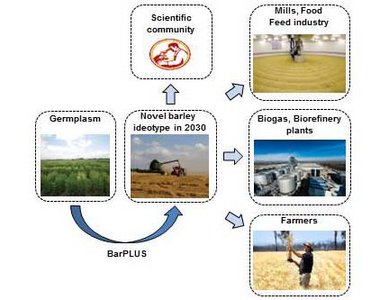BarPLUS
Modifying canopy architecture and photosynthesis to maximize barley biomass and yield for different end-uses (BarPLUS)

Barley is a major crop worldwide, with Europe producing the greatest share (~60 MT/yr). Beside grains, barley plants produce an almost equivalent amount of straw that in the past was considered as a secondary product of minimal value.
The majority of the genetic progress to increase yield was obtained through a change in biomass partitioning from straw to grains and the current plant architecture has been mainly driven by the necessity of increasing the harvest index.
Nevertheless, the increasing demand for renewable materials makes straw, and especially barley straw characterized by the largest content of carbohydrates among cereals, a valuable product for its potential conversion into biofuels and other products.
Indeed, barley crop residues are desirable feedstocks because of their low cost, immediate availability, no competition with food, and relatively concentrated location in the major grain growing regions. Given this perspective, partners within the BarPLUS project believe that the current barley plant architecture, together with photosynthesis performance, should be revised to maximize the farmer income (grain value plus straw value).
OBJECTIVE
BarPLUS would identify genes, alleles and lines needed to increase barley plant biomass, without penalty on grain yield, in the agro-climatic and management scenarios predicted for 2030 in Southern (Spain and Italy) and Central (Germany and Poland) Europe.
METHODOLOGY
This goal will be achieved through:
• Modifications in plant architecture - tillering, leaf size and angle
• Photosynthetic process improvement, either intrinsically or indirectly through maximizing radiation use efficiency.
BarPLUS takes advantage of genetic, physiological and molecular biology tools combined with in silico modeling to produce knowledge on genes and alleles and provide lines to breed a new barley ideotype.
RESULTS AND KEY FINDINGS
During the first half of the experimental plan, BarPLUS has identified genes, alleles and lines characterized by the traits with the potential to increase biomass production. This knowledge has been achieved by taking advantage of the unique resources of mutants and exome resequencing data available for barley.
The genetic material, in combination with modelling and LCA studies, is used as a starting point to generate a dual-purpose barley variety suitable for the agro-climatic and management scenarios predicted for 2030 in Southern (Spain and Italy) and Central (Germany and Poland) Europe.
Scientific publication
- "PocketPlant3D: Analysing canopy structure using a smartphone"
Biosystems Engineering 164, 1-12.
By Confalonieri, R., Paleari, L., Foi, M., Movedi, E., Veselya, F.M., Thoelke, W., Agape, C., Borlini, G., Ferri, I., Massara, F., Motta, R., Ravasi, R.A., Tartarini, S., Zoppolato, C., Baia, L.M., Brumana, A., Colombo, D., Curatolo, A., Fauda, V., Gaia, D., Gerosa, A., Ghilardi, A., Grassi, E., Margarini, A., Novelli, F., Perez Garcia, F.B., Graziosi, A.R., Salvan, M., Tadiello, T., Rossini, L. (2017)
- "GUN1, a Jack-Of-All-Trades in Chloroplast Protein Homeostasis and Signaling"
Front Plant Sci. 2016 Sep 22;7:1427.
By Colombo, M., Tadini, L., Peracchio, C., Ferrari, R., Pesaresi, P. (2016) - "Photoperiod-H1 (Ppd-H1) Controls Leaf Size"
Plant Physiol. 2016 Sep;172(1):405-15.
By Digel, B., Tavakol, E., Verderio, G., Tondelli, A., Xu, X., Cattivelli, L., Rossini, L., von Korff, M. (2016) - "The influence of fertiliser and pesticide emissions model on life cycle assessment of agricultural products: The case of Danish and Italian barley"
Science of The Total Environment, Volume 592, 15 August 2017, Pages 745-757
By Schmidt Rivera, X.C., Bacenett, J., Fusi, A., Niero, M. (2016)

Coordinator:
Prof. Paolo Pesaresi
Università degli Studi di Milano, Italy
Email: paolo.pesaresi@unimi.it
Project partners:
- Consiglio per la ricerca in agricoltura e l'analisi dell'economia agraria (CRA), Italy
- University of Lleida, Spain
- University of Potsdam, Germany
- University of Silesia, Poland
Project period: 2016 - 2019
Total funding: 920.000 Euro
Visit the project homepage:
barplus.wordpress.com